For years, European car manufacturers have had to comply with strict EU laws on sound levels for production models. A great deal of time and effort is spent to develop suitably subdued exhaust systems. Such mufflers fit the available space and, in some cases, have pressed surfaces and shapes designed to attenuate unwanted sounds like droning. They are also made from good-quality stainless steel, designed to last the lifetime of the car.
Many enthusiasts in North America, however, feel the need for a more aggressive exhaust note because OEM systems are so muted. This means swapping out factory mufflers and/or other components to achieve a more desirable sound quality and volume. A huge pile of OEM mufflers are ditched each year. It's a waste of material, resources, and engineering to toss an OEM muffler into the dumpster. This is where FD Motorsports (FDM) in Brentwood, California, steps in to make admirable use of an otherwise unwanted item.
 | Conservation Piece: FD Motorsports Performance Mufflers
| Conservation Piece: FD Motorsports Performance Mufflers
FDM currently has several lines of Fister-modified OEM mufflers for Porsche 993, 996, 997, and Boxster/Cayman models. Modifications consist of either adding an external partial bypass pipe between the muffler's input and output, making internal alterations to the muffler itself, or a combination of both processes. This usually lightens the muffler by a pound or two and definitely creates a more aggressive, motorsport-inspired accompaniment.
FDM claims these Fister mufflers for the 993 and 993 Turbo have no drone or resonance and are lighter than stock. They also deliver a healthy growl at idle and a more aggressive bark under acceleration, while still being mild during casual driving. The added bonus is that these mods do not affect emissions. A win-win. They're available in three ascending levels of volume coupled with descending weights.
For 996, 997.1, 997.2, and early Boxster/Cayman models, modifications consist of adding a stainless steel external partial bypass pipe to the muffler, along with a couple of proprietary tricks, adding about a pound in the process. Newer Boxster and Cayman versions get an internal treatment that gives a pleasing sound and better flow characteristics. This results in a sportier idle tone and more volume under hard acceleration, yet remains mellow while cruising.
A pair of FDM stage three mufflers on a 993 sounds louder in general (perfect with a helmet on), much more aggressive on throttle, a nice burble off throttle, and an overall refined yet sporty note. It's possible to ship OEM mufflers to FDM for conversion (exchange units are also available). They come back modified and finished in the one of five optional ceramic coating choices.
The company has also started producing aftermarket 200-cell sport cat systems for the naturally aspirated Porsche 993, in cooperation with Leistung Motorsports. These turn up the volume, along with some extra power (10 to 12 whp).
FDM isn't single-handedly saving the world by recycling mufflers, and perhaps our environment is a touch higher in ambient noise because of such modifications. But for enthusiasts, flat-six exhaust sounds are much sweeter.
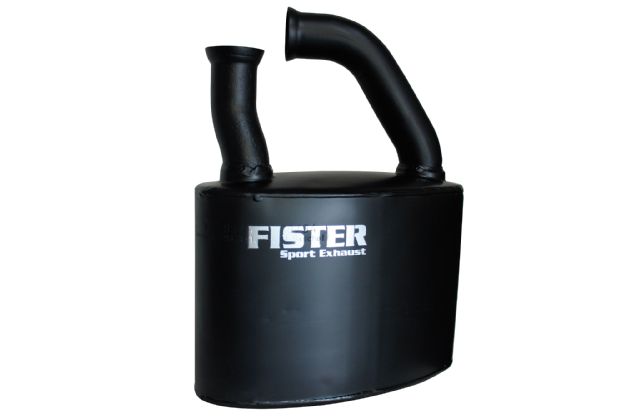 | FD Motorsports Performance Mufflers Fister Sport Exhaust 03
| FD Motorsports Performance Mufflers Fister Sport Exhaust 03
Modern Performance Exhaust 101
To achieve maximum power output from a modern performance exhaust, it needs to be engineered as a complete system from the manifold all the way back to the mufflers. Ideally, a performance exhaust optimizes back pressure and exhaust gas velocity.
The choice of tubing diameter is normally related to engine displacement, output, and rpm operating range. But there is no magic formula to calculate what should be used. Also, diameters need not necessarily be constant from downpipe to muffler tip due to changes in pressure and temperature throughout the system, both of which decrease toward the exit. Bends and curves must also be as gentle as possible to avoid turbulence or restriction. But the available space in modern vehicles is often limited, making this process more difficult.
When modifying modern vehicles, the additional performance potential of the cat-back portion is limited. Swapping out mufflers is not likely to add much horsepower. It will most likely improve sound levels and timbre only. Fortunately, there is usually plenty of room for performance improvements in the header/manifold and catalytic converter sections to make this engineering process worthwhile.
Headers
Improved header design is a major factor for strong performance gains in aftermarket exhaust systems. The main reason is that the measured pressures after the OEM header or exhaust manifold can be lowered by a more efficient design. In other words, the OEM setup is too restrictive. Typically, different header pipe diameters of a prototype are dyno-tested to determine the optimum output that matches displacement and powerband characteristics. It is also important to test the header merge volume and shape to optimize exhaust gas scavenging, balance, and velocity.
 | Conservation Piece: FD Motorsports Performance Mufflers
| Conservation Piece: FD Motorsports Performance Mufflers
High-flow catalytic converters
OEM cats used by most European manufacturers are made with a ceramic material prone to melting in the extreme heat of a highly tuned engine or long sessions on the racetrack. Ceramic cats are also quite restrictive due to thick walls and small cell size, typically 400 or 600 cells per square inch (CPSI).
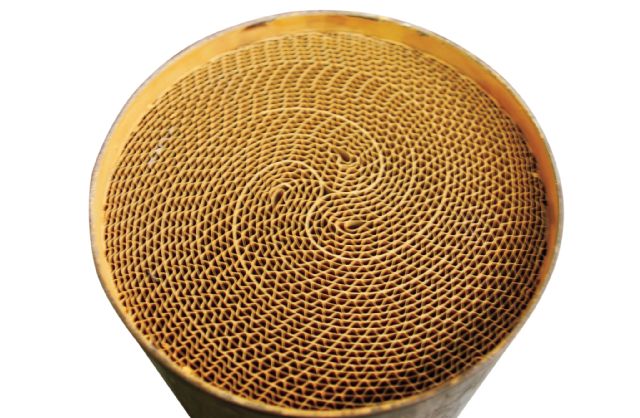 | FD Motorsports Performance Mufflers Catalytic Converter 05
| FD Motorsports Performance Mufflers Catalytic Converter 05
In performance applications, more expensive race metallic cats are used. These have a thin metal foil core. Cell wall thickness is reduced, resulting in less frontal area of the core surface and allowing cells to be larger (100 or 200 CPSI), therefore less restrictive. A metal-core cat's heat resistance is much greater than ceramic. Adhesion of the metal catalysts to the core walls is also improved, which is critical for long-term durability.
High-quality metallic cats are manufactured by a German company, Emitec/HJS, and come in diameters of 93, 108, 120, 130, and 150 millimeters, and cell counts of 100 and 200 CPSI. These varied diameters and cell counts allow for many volume combinations that can alter back pressure profiles. For street use, 200-cell metallic cats are the best choice as they are less likely to activate the "check engine" light.
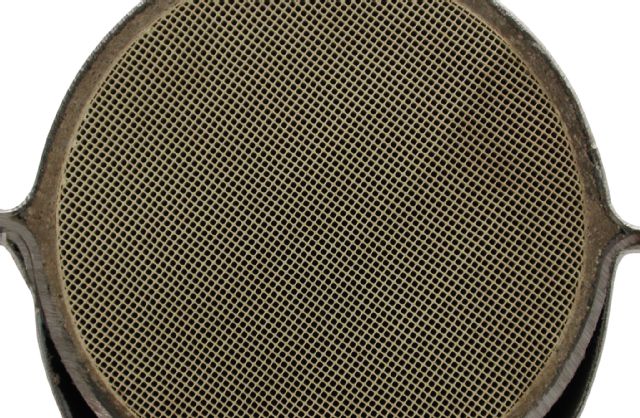 | FD Motorsports Performance Mufflers Catalytic Converter 06
| FD Motorsports Performance Mufflers Catalytic Converter 06
Mufflers
Mufflers must satisfy volume level requirements, conform to the space available, and create a desirable sound. So performance muffler testing can be extensive. Several different designs are usually tested with various canister volumes, shapes, and inner constructions. Such tests will alter the back-pressure profile throughout the system, so care must also be taken not to lose power.
 | Conservation Piece: FD Motorsports Performance Mufflers
| Conservation Piece: FD Motorsports Performance Mufflers
There are several types of flow-through resonated mufflers currently available. Here are some examples. The longer the exhaust path in a flow-through resonated muffler, the quieter the note.
A simple type of muffler is the louder single flow-through resonated design, where exhaust gases move down a perforated tube encased in sound-absorbing materials.
 | Conservation Piece: FD Motorsports Performance Mufflers
| Conservation Piece: FD Motorsports Performance Mufflers
Supersprint's Powerloop double flow-through design optimizes limited space by gently looping the exhaust twice through the insulated muffler housing for additional noise suppression.
AWE Tuning 180 Technology is a cambered resonator that flows exhaust gases through strategically located ports and into reflection chambers. By adjusting the size and location of these ports and chambers on any given application, sound waves exit the chambers and rejoin the main exhaust flow at 180 degrees out of phase, canceling out problematic frequencies.
APR RSC Reflective Sound Cancellation allows for maximum gas flow while completely eliminating in-cabin resonance. This is done with limited use of packing materials and no baffles for a completely straight and free-flowing exhaust path through the muffler. Undesirable sound waves combine (destructively) with each other to attenuate volume and cut the low-frequency tones that create drone.
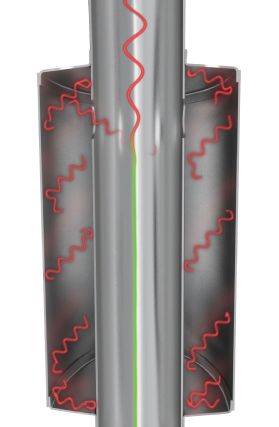 | FD Motorsports Performance Mufflers Resonator 09
| FD Motorsports Performance Mufflers Resonator 09
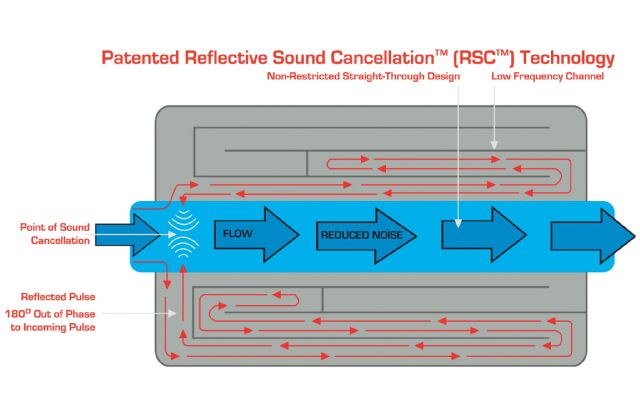 | FD Motorsports Performance Mufflers Resonator 10
| FD Motorsports Performance Mufflers Resonator 10

